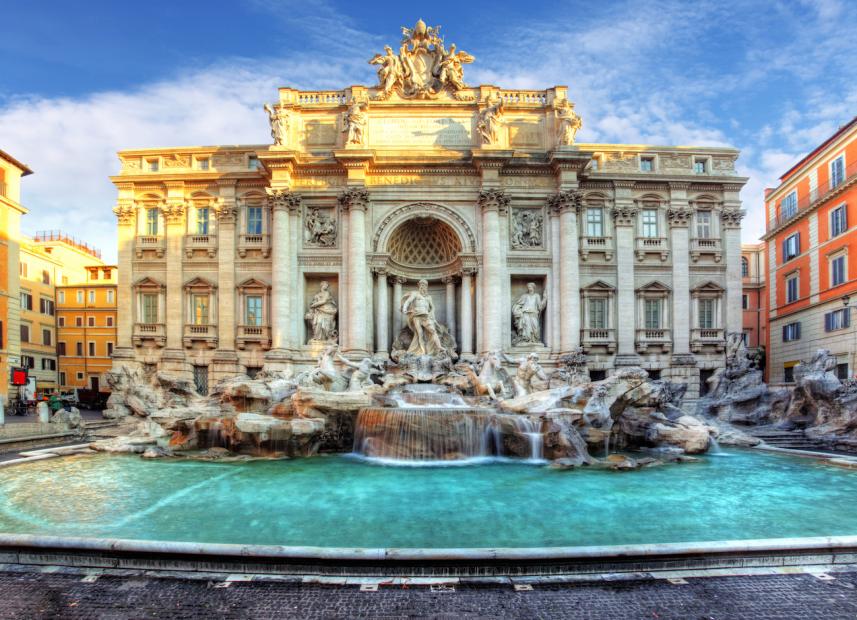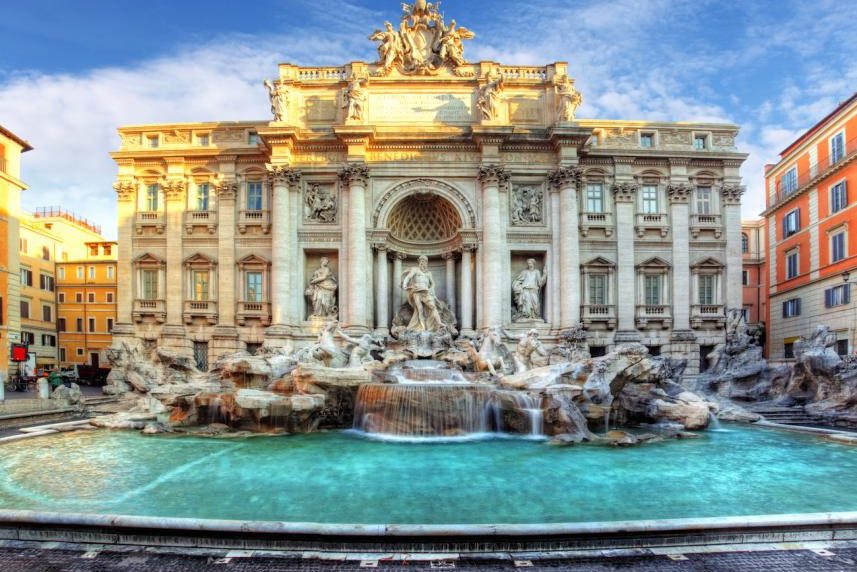Rome is a city famous for its fountains. The largest and most celebrated one is the Fountain of Trevi, so called because it is situated at the center of three converging streets (tre vie). Some say that the Trevi fountain is the most famous fountain in the world. It is a huge, imaginative, theatrical composition of imposing marble beauty, a masterpiece of architecture as well as of sculpture.
The basin of Trevi Fountain was recently refilled with water after months of restoration work drew to an end. Tourists applauded at one of the final stages of the renovation, which began in June last year and cost more than 2 million euros, financed entirely by fashion house Fendi.
The fountain is located in the centro storico of Rome, not far from Piazza di Spagna, and not far from Via del Corso. It rises in the homonym square and is one of the most visited places in Rome and in all of Italy. It is a fountain contained in a monumental architectural and sculptural conglomerate in Post-Baroque style, with a very large water basin in front of it. Its front leans on the large Palazzo Poli, which serves as its background. It is decorated with statues and bas-reliefs on mountains of rocks.
The construction of the fountain itself started in 1453, when Pope Nicholas V had the conduits of the Acqua Vergine repaired. These were the conduits of the waters brought down from the Roman hills in 19 B.C. by Agrippa for his baths near the Pantheon. The original tank was by famous architect Leon Battista Alberti, and the conduits of the aqueducts used to pass through a street that is now appropriately named via Condotti, perhaps the most famous and elegant street in Rome nowadays. The project was complex and continued for many years. It was interrupted by the death of Pope Urban VIII. A hundred years later, however, Pope Clement XII decided to complete it, and did so in a grandiose manner. The first architects were Pietro da Cortona and then the famous Bernini, but the architect who completed the project between 1732 and 1751 was Nicola Salvi.
The fountain overwhelms the piazza in which it rises. It is 20 meters wide and 26 meters long. In the center, in the largest niche, stands the huge statue of Neptune on a seashell pulled by two sea horses in turn guided by Tritons. The sea horses have been nicknamed Furious and Placid, obviously from the way they were characterized by the sculptor. All around, immense mass of rocks. The prospect is adorned by four Corinthian columns covered by a large attic. At the sides there are two lateral niches which contain the statues of Abbondanza (left) and Salubrità (right), that is, abundance and health. The coat of the Orsini family stands on the cornice. The fountain complex is symbolic and replete with mythological allusions. The arch of Triumph, represented by the Palace of Neptune, dominates the scene from above. The fountain is surrounded by a large balustrade. Above the main niche a fine bas-relief by Andrea Bergondi depicts Agrippa approving the plans for the aqueduct in Roman times. The fountain was once celebrated for its excellent waters, but its fame grew and was magnified by Hollywood movies. Do you remember the romantic movie Three coins in the Fountain and its famous song?
Do you remember the delightful Roman Holidays with Audrey Hepburn and Gregory Peck? And who does not remember the scene in Fellini’s La Dolce Vita, in which the statuesque Swedish actress Anita Ekberg wades and frolics in the waters of the fountain at night? It is one of the most famous scenes of the movie, and perhaps the reason why it is illegal now to go into the fountain. After Anita, every starlet wanted to jump in! Nowadays, the fountain is protected by many guards.
A beautiful 18th century French print from my collection shows the entire fountain complex as it was then. Now, the neighboring houses and streets crowd closer, and the throngs of tourists, especially in the summer, made it almost impossible to get a full vue. I took a picture for this article precariously perched on a cement post above the sea of heads! Tourists come to throw coins into the water because, the legend says, this guarantees their return to the Eternal city.
Mothers give coins to children to throw into the water, honey-mooners throw coins together. A guard tells me that the coins are periodically collected and given to charity. Coin after coin, the waters of the fountain have collected millions through the years.






























